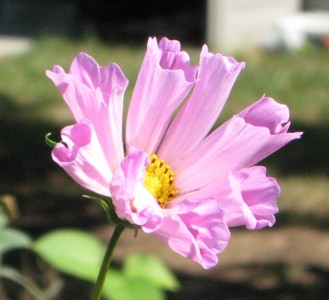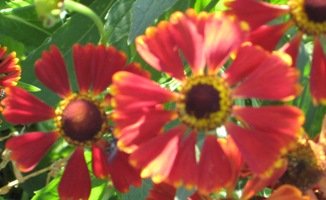





(Editor's Note: This article was originally published on April 29, 2008. Your comments are welcome, but please be aware that authors of previously published articles may not be able to promptly respond to new questions or comments.)
WHY?
There are many reasons to start gardening with containers instead of in the ground. Your soil may be poor, unsuitable for gardening, or needing much amending. You may have a gorgeous ceramic container that needs the perfect plant to set it off. You may have a favorite plant with particular light or heat requirements that can't otherwise be met. Like me, you may have a tiny space in which to garden, or be restricted to a balcony, patio or deck.
HOW?
Obviously you need a container, a growing medium - something to hold the plants up - and plants. But what kind of container, what type of soil, and which plants are all questions you'll need to consider. In my haphazard approach, I have once or twice or more often, like maybe ten times, left a plant in its nursery pot way, way, way too long, so some of my 'wisdom' is based on these interesting learning experiences.
THE CONTAINER - should be one that you like, because, as in the picture above (photo and design, DG member rcn48, of Betula 'Filigree Lace') the container can contribute as much to the pleasing aesthetic qualities of the final product as the plant does. The Container Gardening Forum is sure to have some unusual ideas, as do recent articles by other Dave's Garden authors (referenced below). The pot should hold enough dirt (or soilless growing medium) to hold moisture until the next time you water. The most important factor in a container's suitability is does it have a drainage hole? I believe more plants have been killed by overwatering rather than underwatering. Your container must have a drainage hole!
In many cases, if the pot is not completely irreplaceable, you may be able to drill one yourself, using a drill bit designed for drilling pottery and keeping a steady flow of cold water dribbling over the drill bit while drilling.
THE MIX - I started out by scraping up dirt from the yard and putting it into a pot. This is a mistake (not to mention tough to do, with my compacted city dirt). Although many, many sources will tell you ordinary potting mix (from a bag) is fine, DG member Tapla advocates a rapidly draining mix of pine bark fines (very small pieces of partially composted pine bark), grit or vermiculite, and other ingredients. You can access his thread here. Again, it all comes down to drainage. Different soils are sold in bags for different plants - orchid potting soil, cactus potting soil, etc. Those may be fine for those specific purposes, or you can blend your own. What you want is a mix that will allow the water and any built-up fertilizer salts to drain completely every time you water while aerating the roots thoroughly.
Most people wind up using some type of soilless potting medium. After all, dirt is just a vehicle to provide the roots of the plant with oxygen and water - which we need too! Plants, like people and other living things, also need nutrients, like phosphorus (P), potassium (K) and nitrogen (N), as well as various micronutrients. Be sure to include these in your plant's diet, usually with some type of "all-purpose" fertilizer.
Should you use moisture-retaining crystals? Some people are strongly in favor of them. Others, like me, are wary of damaging the environment. But then, I live in the Northeast U.s., which has been getting enough water for a while and in a town with an unusually high water table. We have too much water, not a shortage. I guess, in the end, it comes down to individual trial and error, and how often you're able to water. As fellow DG author Lee Anne Stark points out, each time you water can be a time to assess the overall health of the plant.
One more thing about drainage: contrary to what you will read, on this site and in other sources, a layer of gravel in the bottom of the pot doesn't help drainage. It reduces the amount of soil available to supply oxygen and water to the roots of the plant. To ensure drainage, as well as having the drainage hole, be sure your plant in its pot is not sitting in a damp puddled spot, but is on well-draining earth. You can even put the whole pot on that layer of gravel .
THE PLANTS - many, many different types of plants are suitable for planting in containers, at least for a while.
We've all seen coleus, African violets or potted palms. Who hasn't stuck impatiens, pansies or zonal geraniums into a window box? In my tiny backyard, I grow nearly everything in containers, at least while the plant and I are deciding whether we like each other o r not. I plant annuals (cosmos, left), herbs, and occasionally even vegetables in containers.This summer, I plan to try Jan's patio single-serving cantaloupes!
r not. I plant annuals (cosmos, left), herbs, and occasionally even vegetables in containers.This summer, I plan to try Jan's patio single-serving cantaloupes!
But did you know that you can pot perennials in containers? It's slightly trickier, but it can certainly be done. I frequently pot up a perennial in a container for the summer while I'm deciding which one of my tiny beds has space for one more plant. If you wish to situate a perennial in a pot permanently, choose a plant hardy enough to handle a winter two or more zones colder than yours is, since the pot offers less protection from the elements than being sunk in the ground would. And the pot needs to be tougher too - nothing dainty or breakable if it's to survive freezes and thaws. If it can be thick (fiberglass? wood? brick? stone?) that's certainly a plus, although I confess my yard is full of plastic pots (as well as broken pretty ceramics).
The Helenium on the right is ready to be squeezed into a permanent spot - as soon as I find one. We've go tten to know each other, I know that it's red and not yellow, and how tall it gets. The poor plant has had a chance to experience how bad a New England winter can be. Helenium is supposed to be quite hardy, so I don't feel that this was a huge risk. If I were worried, I could have planted it in the fall, or wrapped it in burlap or leaves or both, or even put it in a sheltered location for the winter, although my containers are already nestled in the crook between the kitchen and the garage.
tten to know each other, I know that it's red and not yellow, and how tall it gets. The poor plant has had a chance to experience how bad a New England winter can be. Helenium is supposed to be quite hardy, so I don't feel that this was a huge risk. If I were worried, I could have planted it in the fall, or wrapped it in burlap or leaves or both, or even put it in a sheltered location for the winter, although my containers are already nestled in the crook between the kitchen and the garage.
For more information... try some of these great forums right here at Dave's Garden:
Annuals
Cactus and Succulent
Coleus
Container Gardening
Perennials
And here are some Dave's Garden articles that are about containers or growing various plants in them:
Reviving old plastic pots
Pot Potential
Grow mini-cantaloupes
Overwintering coleus
Make a Planter From Blue Jeans
Pot Ideas for Succulents
Mulching Indoor Plants
Container Gardening to the Max
Copyright © www.100flowers.win Botanic Garden All Rights Reserved